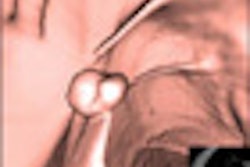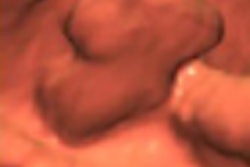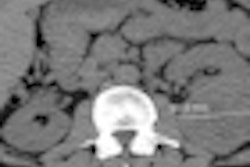A study of more than 1,400 individuals screened with virtual colonoscopy found that the technique is effective in patients 65 years and older, researchers report in the July issue of the American Journal of Roentgenology.
The research from the National Naval Medical Center is the latest of several studies to find similar results between Medicare-aged screening subjects and traditional screening populations ages 50 years and older.
Only about 14% of subjects undergoing virtual colonoscopy (also known as CT colonography or CTC) were referred to conventional colonoscopy for removal of a polyp 6 mm or larger, the study group found. That result, combined with a prevalence of less than 3% for advanced extracolonic findings, makes CTC screening a viable option in Medicare-aged patients, concluded the authors (AJR, July 2012, Vol. 191:1, pp. W27-W34).
Conventional colonography can reduce morbidity and mortality from colorectal cancer (CRC), and CTC has been shown to provide equivalent detection of clinically significant colorectal lesions in a screening population ages 50 years and older.
However, the U.S. Preventive Services Task Force (USPSTF), in its noncoverage decision memorandum of May 2009, said that evidence to date was inadequate to conclude that CTC would also be effective in an older, Medicare-aged population.
The agency was also concerned about CTC's inability to reliably detect polyps 6 mm and smaller, and the effects of cumulative radiation exposure on individuals undergoing CT screening every five years.
The current study was aimed, in part, at addressing those data deficiencies and demonstrating that CTC can screen an older population without an excessive number of referrals to conventional colonoscopy; such referrals would undermine CTC's utility and cost-effectiveness as a less-invasive gatekeeper that would eliminate the need for invasive colonoscopy in most cases, wrote Dr. Brooks Cash, from the National Naval Medical Center (NNMC), and colleagues.
The study measured the colonoscopy referral rate and compliance, and the researchers described the nature and prevalence of extracolonic findings in older patients.
The results are "similar to other CTC trials involving younger patients as well as the two other reports of CTC in older patients," wrote Cash and NNMC colleagues including Dr. Mark Riddle and Dr. Ishan Bhattacharya, along with Dr. Perry Pickhardt from the University of Wisconsin.
The retrospective analysis included 1,612 average-risk screening subjects 65 years and older (mean age, 75 years) who underwent screening CTC between 2004 and 2009.
All patients underwent cathartic bowel cleansing followed by automated insufflation of the colon with CO2 (ProtoCO2l, Bracco Diagnostics) prior to imaging on an MDCT scanner using 120 kVp, 30-60 mAs, 1.5-mm slice thickness, 1.25-mm reconstruction interval, and 40 x 0.625-mm collimation.
CT data were transferred to a workstation that allowed synchronized prone and supine 2D and 3D endoluminal navigation and examination. The images were interpreted using primary 3D interpretation followed by 2D CT for problem-solving. Finally, extracolonic findings were evaluated on the 2D CT source images in the coronal, sagittal, and axial planes. All data were examined by radiologists experienced in CTC interpretation.
There were no complications in any patients as a result of CTC or conventional colonoscopy. Images were reported using the C-RADS lexicon.
Colorectal neoplasia was found in 9.3% (131/1,410) of the overall cohort, and potentially important extracolonic findings were seen in 2.9% (41/1,410).
The overall frequency of referral to colonoscopy for C-RADS C2-C4 lesions detected at CTC was 14.5% (198/1,364), Cash and colleagues reported.
In all, 191 patients (14%) completed colonoscopy after CTC. Of these, 10% (19/191) had a C0 CTC interpretation per the C-RADS CTC reporting schema; 55% (105/191) had a C2 interpretation; 34% (65/191) were classified as C3; and 1% (2/191) were classified as C4.
The 476 polyps or mass lesions seen in the 14% of patients who proceeded to colonoscopy included 289 polyps (60.7%) smaller than 6 mm, 119 polyps (25%) 6 to 9 mm, and 68 lesions (14.3%) 10 mm or larger.
No advanced neoplasia was found among polyps smaller than 6 mm; however, 5.8% of the 119 6- to 9-mm polyps were removed at colonoscopy, including one cancer, Cash and colleagues wrote.
Among the polyps 10 mm and larger, 67.9% fulfilled the criteria for advanced neoplasia. Carcinoma was identified in three (4.4%) of the 68 lesions, along with high-grade dysplasia in five (7.3%).
The average effective radiation dose during the time period of the study was 4.24 mSv per CTC exam.
An option for Medicare patients?
"The low rates of referral to colonoscopy, prevalence of advanced neoplasia, and prevalence of extracolonic findings make CTC a viable option for Medicare-aged patients," the authors wrote.
A previous study by Kim et al found a colonoscopy referral rate of 15.3% in 577 seniors, while a previous study by Macari et al found that 8.4% of 250 seniors had at least one 6- to 9-mm polyp, with an implied colonoscopy referral rate of 14.1%.
In terms of limitations, the retrospective nature of the analysis and the use of protected health information limited the ability to evaluate possible study confounders or other outcomes, the authors noted. The study design did not permit a comparison of CTC's accuracy with that of colonoscopy, though numerous comparisons exist in the literature.
"None of the diminutive polyps identified and removed during colonoscopy harbored advanced neoplastic features, a reassuring observation in this group of older patients," they wrote. "Conversely, advanced colorectal neoplasia was identified in almost 6% of patients with small (6-9 mm) polyps, supporting current recommendations for referral of these patients to colonoscopy for polypectomy."
Approximately one in eight of the older patients in the study were referred for conventional colonoscopy, and CTC identified advanced colorectal neoplasia in 3.3% of patients, Cash and colleagues concluded.
"Both of these outcomes are similar to other CTC trials involving younger patients, as well as the two other reports of CTC in older patients," they wrote.
Extracolonic findings are common in this older population, but most are not clinically relevant and do not require additional testing based on the C-RADS reporting criteria.
"Given the wide acceptance of the value of CTC as a CRC screening test and the increasing amount of data supporting the practice in older patients, we believe that CTC screening and surveillance for CRC in Medicare-aged patients is a viable alternative to other tests and should be reconsidered for endorsement by both the USPSTF and [the Centers for Medicare and Medicaid Services (CMS)]," they wrote.



















